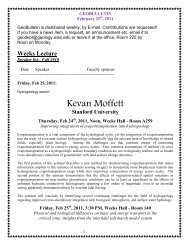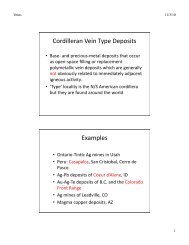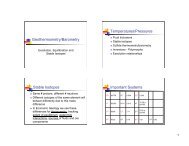Electron microprobe dating of monazite
Electron microprobe dating of monazite
Electron microprobe dating of monazite
Create successful ePaper yourself
Turn your PDF publications into a flip-book with our unique Google optimized e-Paper software.
40 J.-M. Montel et al. / Chemical Geology 131 (1990)37-53<br />
creates a maximum overestimate <strong>of</strong> the Pb content <strong>of</strong><br />
about 30 ppm. Standards are ThO 2, UO 2, and a<br />
synthetic glass (CaO-AI20-SiO 2) with 6200 ppm<br />
<strong>of</strong> lead made in our laboratory. The counting time<br />
for standards is 50 s on peak and 100 s on back-<br />
ground for ThO 2 and UO 2, and 300 s on peak and<br />
600 s on background for Pb glass. The peak-back-<br />
ground ratio is imposed by the machine. For <strong>dating</strong>,<br />
the counting time governs the precision on the U, Th<br />
and Pb contents and thus the final precision on the<br />
age. It varies from 30 to 300 s, depending on the<br />
nature <strong>of</strong> the sample. At the moment, we use 100 s,<br />
repeating the analyses when necessary to get a longer<br />
total counting time. Only U, Th and Pb are mea-<br />
sured, and the ZAF matrix effect correction proce-<br />
dure is carried out using an average <strong>monazite</strong> com-<br />
position for elements other than U, Th, and Pb. The<br />
ZAF factor is about 1.00 for Pb, and 1.21 for U and<br />
Th.<br />
Errors and detection limits are calculated using<br />
the statistical approach <strong>of</strong> Ancey et al. (1978), which<br />
is based on the fact, demonstrated experimentally,<br />
that photon counting in X-ray analysis follows Pois-<br />
son's law. For each measurement, the confidence<br />
intervals for Th, U, Pb are determined, the age is<br />
computed from Eq. (1), and the uncertainty on the<br />
age (95% confidence) is calculated by propagating<br />
the uncertainties on Th, Pb, and U into Eq. (1). So<br />
each measurement yields an age with a statistical<br />
confidence interval. Hereafter age results are given<br />
with this statistical error only, to allow unbiased<br />
inter-sample age discrimination. Two other system-<br />
atic sources <strong>of</strong> error must be considered. One results<br />
from the fact that we use an average <strong>monazite</strong><br />
composition in the ZAF correction procedure, in-<br />
stead <strong>of</strong> the true composition. Montel et al. (1994)<br />
estimated by a Monte-Carlo simulation procedure<br />
that this produces an additional uncertainty on the<br />
final age <strong>of</strong> 1% relative. The other source <strong>of</strong> error<br />
lies in the uncertainty on the composition <strong>of</strong> the Pb<br />
standard (1% relative uncertainty on the final age).<br />
The precision in electron probe <strong>dating</strong> <strong>of</strong> <strong>monazite</strong> is<br />
less than by isotopic <strong>dating</strong>. On a single measure-<br />
ment, it varies from _+ 30 Ma lot a Th- and U-rich<br />
<strong>monazite</strong> with 300 s counting time to _+ 100 Ma for<br />
an average <strong>monazite</strong> with 30 s. As an additional<br />
check <strong>of</strong> the quality <strong>of</strong> the analyses, we perform, at<br />
the beginning <strong>of</strong> any session, the complete procedure<br />
on a well-dated <strong>monazite</strong> (Madagascar sample, see<br />
below), that we use as an 'age standard'.<br />
2.4. Data presentation<br />
Numerous ages can be obtained on a single thin-<br />
section, e.g. 20 to 70 in less than 2 h. A simple<br />
graphical display <strong>of</strong> a data set is by histograms, but<br />
in this particular case, because the error on each<br />
measurement is large, histograms would require large<br />
classes (<strong>of</strong> about 200 Ma), which would give a rather<br />
crude representation <strong>of</strong> the age population. Instead <strong>of</strong><br />
representing each age measurement by a point (as in<br />
the histogram presentation) we prefer to display its<br />
bell-shaped probability curve, as defined by the age<br />
and standard deviation. A 'weighted histogram' rep-<br />
resentation is then given by the sum <strong>of</strong> all n bell-<br />
shaped curves (Hurford et al., 1984). This graphical<br />
representation may allow to visualize whether the<br />
population <strong>of</strong> age data is consistent with a single<br />
geological event, or unambiguously defines two suc-<br />
cessive events, or is too broadly dispersed, or shows<br />
a few outliers, etc. However, this does not spare a<br />
quantitative modelling.<br />
2.5. Modelling<br />
It is a classical problem in statistics to find the<br />
best estimate a and standard deviation % <strong>of</strong> some<br />
quantity (here the age <strong>of</strong> a geological event) from a<br />
collection <strong>of</strong> n independent estimates T~ with stan-<br />
dard deviations O-r, (here the <strong>microprobe</strong> ages <strong>of</strong> n<br />
supposedly synchronous domains in some <strong>monazite</strong><br />
crystal or crystals). The least-squares modelling is<br />
easily extended (see Appendix A to cover situations<br />
where there are domains <strong>of</strong> two or more geological<br />
ages (a, b .... ) with no a priori knowledge <strong>of</strong> which<br />
domains relate to which geological event. Whatever<br />
the supposed number <strong>of</strong> age components, m, the<br />
model is valid only if the so-called MSWD (mean<br />
square <strong>of</strong> weighted deviates; McIntyre et al., 1966) is<br />
sufficiently close to 1. More precisely, we require<br />
that the accumulated probability function <strong>of</strong> the<br />
MSWD, Pf (x) (Wendt and Carl, 1991), taken at<br />
f= n - m (the number <strong>of</strong> degrees <strong>of</strong> freedom) and<br />
x = MSWD (see Appendix A, lie within some pre-<br />
scribed limits. In practice we impose 0.05 < Pt





